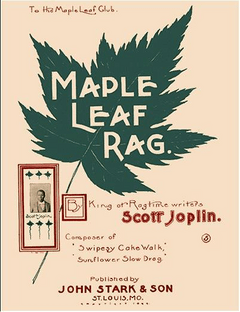Ragtime facts for kids
Quick facts for kids Ragtime |
|
|---|---|
| Stylistic origins | Cakewalk, African American folk music |
| Cultural origins | 1890s: US |
| Typical instruments | Mainly piano, sometimes banjo orchestra, brass band |
| Derivative forms | Stride, novelty piano, honky tonk Quickstep, Foxtrot |
| Fusion genres | |
| Jazz - boogie woogie - bluegrass | |
Ragtime is a fun and lively type of music that was very popular between 1897 and 1918. It's known for its special rhythm, which sounds a bit "ragged" or uneven. This is called syncopation.
Ragtime started as music for dancing in American cities like St. Louis and New Orleans. It was played for years before it became popular sheet music for the piano.
Ragtime music was inspired by the march style, which John Philip Sousa made famous. It also added polyrhythms, which are different rhythms played at the same time. These rhythms were common in African music.
A famous ragtime composer named Scott Joplin became well-known in 1899. This was after his song Maple Leaf Rag was published. Many other ragtime hits followed. For over 12 years, Maple Leaf Rag influenced other composers. It shaped how they wrote melodies and harmonies.
Contents
What Is Ragtime Music?
Ragtime is a unique style of music. Its most important feature is its "ragged" or syncopated rhythm. This means that the strong beats in the music don't always fall where you expect them to. It makes the music sound bouncy and exciting.
Imagine tapping your foot to a song. In most music, you tap on the main beat. In ragtime, the melody often plays between those main beats. This creates a fun, off-beat feeling.
How Ragtime Sounds
Ragtime is usually played on the piano. The left hand plays a steady, march-like rhythm. It keeps the beat going. Meanwhile, the right hand plays the catchy, syncopated melody.
This combination of a steady bass and a "ragged" melody is what gives ragtime its special sound. It makes you want to dance!
The Rise and Fall of Ragtime
Ragtime music was very popular in the early 1900s. People loved to dance to it. It was often played in dance halls and saloons.
However, after 1917, jazz music started to become more popular. Ragtime slowly lost its top spot. But it didn't disappear forever!
Ragtime's Comeback
Ragtime has had several comebacks over the years. In the early 1940s, many jazz bands started playing ragtime songs again. They even released new recordings.
A bigger comeback happened in the 1950s. More old ragtime styles became available on records. New ragtime songs were also written and recorded.
Ragtime in Movies
In 1971, a musician named Joshua Rifkin released an album of Scott Joplin's music. It was so good that it was nominated for a Grammy Award.
Then, in 1973, a movie called The Sting used Joplin's songs for its soundtrack. This helped many people discover ragtime music. The movie's version of Joplin's 1902 song The Entertainer became a huge hit in 1974.
Ragtime's Influence on Other Music
Ragtime is considered a very important part of American music history. Some people compare it to famous classical music styles. For example, they might compare it to minuets by Mozart or waltzes by Brahms.
Ragtime also influenced many classical composers. These included Erik Satie, Claude Debussy, and Igor Stravinsky.
Ragtime was also important for dance. It was used by famous dancers like Vernon and Irene Castle. It also influenced English ballroom dances, such as the foxtrot and the quickstep.
Images for kids
-
Scott Joplin was called the "King of Ragtime" because of his amazing songs.
-
This is "The Top Liner Rag" by Joseph Lamb, a classic song from 1916.
-
The first page of "The Easy Winners" by Scott Joplin shows its special ragtime rhythms.
-
This is James Scott's 1904 song "On the Pike." It refers to the St. Louis World's Fair of 1904.
See also
 In Spanish: Ragtime para niños
In Spanish: Ragtime para niños









